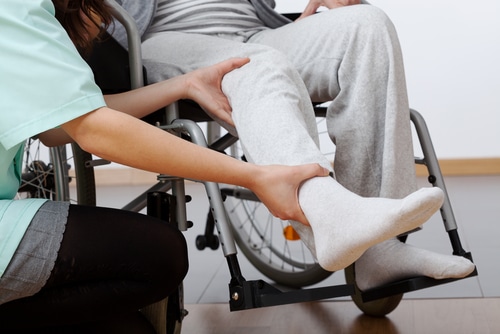Most people are aware that spinal cord injuries cause partial or total paralysis from the injury downwards. But not as many know it routinely causes autonomic dysreflexia, a potentially life-threatening condition.
Autonomic dysreflexia affects the autonomic nervous system, which regulates many crucial functions. Like for example, things like breathing, heartrate and blood pressure.
Most of us rarely think about these routine bodily functions, at least not until they don’t function as we expect them to. For people who live with paralysis, autonomic dysreflexia is a constant concern.
Autonomic dysreflexia symptoms
With autonomic dysreflexia (AD), extremely high and low blood pressure can be triggered without warning. This is a major blow to a person’s nervous system. When your blood pressure suddenly plummets it can lead to fainting. And on the flip side, when it skyrockets it can be serious enough to cause strokes or heart attacks.
Living with autonomic dysreflexia means you can also experience spasms, skin discolouration, sudden intense sweating, blurry vision, confusion, headaches and more.
We asked accessible artist and clothing designer Carol Taylor to share insights about living with autonomic dysreflexia. Here’s what she says:
Essentially, having a spinal cord injury can result in blood pressure levels fluctuating in the extreme, suddenly and without warning, the results of which can be life threatening. I have taken my lived experience of this condition into account in my adaptive clothing designs.
Watch this video on AD from the New Zealand Spinal Trust:
Autonomic dysreflexia causes
One of the main causes of AD is a spinal cord injury (SCI) in the upper back. That’s because the nerves in the paralysed area don’t stop trying to communicate with your brain. Essentially the body continues trying to work the way it should despite a disruption along its communication channels.
Unfortunately when this happens your nerve responses may end up going into overdrive, leading to autonomic dysreflexia. SCIs are among the common causes, but they aren’t the only reason a person may experience the condition.
Here’s a non-exhaustive list of things that can cause autonomic dysreflexia:
| Guillain-Barré syndrome | A nervous system disorder |
| Brain injury | Severe head trauma |
|---|---|
| Drug use | Side effects of stimulants |
| Subarachnoid hemorrhage | Bleeding in the brain |
What triggers an autonomic dysreflexia episode?
Now that we’ve looked at conditions that can cause autonomic dysreflexia, let’s look what can trigger an autonomic dysreflexia episode.
In layman’s terms the thermostat in my brain which regulates my body temperature doesn’t work properly so I often experience unexpected fainting because my blood pressure has dropped without warning and conversely I can experience sudden increases in blood pressure as a result of a change in temperature.
– Carol Taylor – mother, wife, lawyer, designer, artist, quadriplegic
Lots of things can stimulate our senses and cause a physical response, like clothes being too tight, too warm or too cool or needing to empty the bladder or bowels. Even period pain or sexual intimacy can cause AD
. When, however, you can’t feel these bodily sensations due to an SCI, your body can react by pushing your blood pressure to the extreme – causing an episode.

Treatment
An autonomic dysreflexia episode requires immediate medical attention. If blood pressure is too high any tight or warm clothing needs to be removed and the person’s head should be raised and feet lowered, to help reduce blood pressure to the brain.
However, if the blood pressure is too low and fainting is imminent then the opposite is required. The wheelchair needs to be placed in recline so the head is low and the feet are high, allowing blood to flow to the head and the restoration of normal blood pressure.
A doctor can do a number of different tests to find out what caused the episode and work on remedying it. Tests can include bloodwork, X-rays, MRI, CT, ECG and more.
Often they’ll work on ruling out conditions with similar symptoms and will usually check whether there are urinary or bowel blockages, as these are common triggers.
Autonomic dysreflexia treatment can include a range of approaches, including stopping medication that’s causing episodes and taking preventative medicine. In some cases it can also require surgery. Last year Carol had to be rushed to hospital for an unexpected surgery. Here’s why:
People with SCI can’t “feel” pain in the same way that you might. Unknown to me there was a large kidney stone in my bladder causing pain I couldn’t “feel”. My body let me know it was not happy by skyrocketing my blood pressure to life-threatening levels resulting in emergency surgery.
Blood pressure
Carol tells us “I carry a bottle of GTN spray in my backpack everywhere I go. In the event that my blood pressure increases to dangerously high levels and I’m unable to figure out what the stimulus is to bring it back to normal, it’s essential that I MUST have a single spray of GTN under my tongue.
This will immediately cause my blood pressure to drop hopefully allowing sufficient time for the ambulance to arrive. This is what happened to me last year before having surgery to remove the large stone in my bladder. When the paramedics arrived to take me to hospital they administered further sprays in the ambulance until I arrived at emergency.”
A soft landing
Living with an SCI and experiencing autonomic dysreflexia can be stressful and dangerous. It requires ongoing attention and thought as part of the reality of managing life with disability.
Just like having health insurance, knowing you have insurance for your wheelchair and other valuable mobility equipment if they’re damaged or stolen can help you focus on things you need to. Like preventing an autonomic dysreflexia episode by wearing the most comfy adaptive clothing (that’s not too tight and assists with temperature regulation).
Find out about getting as much as 25% off your disability car insurance with your disability parking permit by contacting us today.









